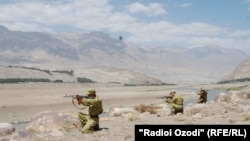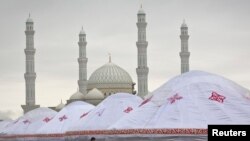
A murky security operation on Tajikistan's border with Afghanistan on March 5 brought attention briefly back to an area that for nearly 25 years has rarely seen an entire week pass without some sort of incident taking place.
The reported firefight between Tajikistan's security forces and an armed group from Afghanistan that left a Tajik border guard and one of the Afghan combatants dead comes as the situation on both sides of the frontier is changing -- and as warmer spring weather heralds the likely start of increased hostilities in areas of northeastern Afghanistan that border Tajikistan.
There is a lot in play at the moment along Tajikistan's frontier with Afghanistan's border provinces of Badakhshan, Takhar, and Kunduz.
Some of the processes underway might lead to a further deterioration in the security situation along this almost perpetually unquiet border. However, the Afghan government's renewed attention might help government forces gain better control over the area.
This week, RFE/RL's Turkmen Service, known locally as Azatlyk, assembled a Majlis, or discussion panel, to assess what happened along the Tajik-Afghan frontier on March 5 and, more importantly, to talk about what is changing along either side of the border.
Azatlyk director Muhammad Tahir moderated the panel. Participating from Dushanbe was Rashid Ghani Adbullo, an independent political analyst, while Amin Mudaqiq, the director of RFE/RL's Pakistani service, known locally as Mashaal, joined in from a studio in Prague where I was also in attendance. Although I wanted to hear what our guests said, I threw in a few comments of my own as well.
Traffickers Or Militants?
The discussion started with the recent incident along the border. There have been several versions of what happened. According to Abdullo, "the first report was done by Tajik border guards. They say that there was a group of traffickers and the border guards clashed with them." Nonetheless, Abdullo later added that "based on reports from the Afghan government, the [Tajik] national security [committee] for the border said it was a group of Taliban."
Mudaqiq spoke with a journalist in Kunduz on March 9 who said the border incident on March 5 started "when [Tajik] government forces pushed the Taliban to the bank of the Amu River (Amu-Darya) [where] there are some small islands which are disputed… Some Taliban, fearing the government's heavy artillery and tank fire, fled to [a] small island, and the Tajik border guards from the other side saw [them] and then a helicopter gunship came and bombarded the area."
Whether this armed group consisted of drug traffickers or militants remains unclear. It was suggested that they could be both and Mudaqiq said that, at the very least, "drug traffickers are always escorted by the Taliban; they prepare the security and the drug traffickers move on in this area."
The topic of cooperation between Tajik and Afghan security forces came up and --while it was agreed that collaboration is better it than it was five or 10 years ago -- it was also agreed that there is much which can still be done.
Abdullo mentioned that the Tajik side has difficulties knowing whom to contact on the Afghan side of the border when a problem erupts. "There are a lot of field commanders," he said. "When everybody who can gather around himself 10, 20, or 50 persons considers himself a source of law, it's very difficult for [information] to be exchanged."
According to Mudaqiq, during this recent occurrence along the border, "Afghan forces were complaining in Takhar that, in this particular incident, they had already informed the Tajik side but they [the Tajik authorities] didn't take it seriously."
Afghan forces now seem to be genuinely paying more attention to the situation in the northeastern part of the country.
Mudaqiq noted that, after the Taliban briefly captured Kunduz city in late September last year, the Afghan government restructured its forces in northeastern Afghanistan.
"After the fall of Kunduz, the Afghan government now has a central command for what they call the northeastern zone -- both the police of the Pamir command and the Afghan military's 20th Division [are] now based in Kunduz," he said. "Both of these military entities are in charge of the whole area from Badakhshan to Kunduz."
Russian Troop Reductions
At the same time, Russia, which has in recent years frequently voiced concern about security along Tajikistan's border with Afghanistan, seems to be taking less of an interest in events there.
The Russian 201st Division has remained stationed in Tajikistan since the 1991 collapse of the U.S.S.R. and, as recently as late 2015, Russian military officials spoke about augmenting its forces there. However, the Russian military declared at the end of January that it would reduce the number of troops in Tajikistan. This news came after the 201st withdrew last year from Kulob -- one of its three bases in Tajikistan and the base closest to the Afghan border.
The announcement about troop reductions also came after Russia's ambassador to Afghanistan confirmed late last year that Russian officials met several times during the summer of 2015 at the Kulob base with Taliban representatives from northern Afghanistan.
A December 29 article from the independent Tajik news agency Asia-Plus identified one of the Taliban officials at the Kulob meetings as Qari Dinmuhammad Hanif, a commander who controls the Darqad district in Takhar Province, "which borders on the Farkhor district of [Tajikistan's] Khatlon region." The article said that Afghan government forces could not retake the Darqad district from the Taliban because "it is guarded with Russian weapons, and this province will remain the point of Russia's link with the Taliban."
Speaking about Russia's decision to reduce troops in Tajikistan, Abdullo put forward the idea that the move has more to do with Russia's experience in Syria. "It was possible for them in a very limited time to bring a lot of forces from Russia to the main [Syrian] airbase," Abdullo said, adding that "maybe they will not need to keep [as large a] force as it was previously in Tajikistan." Instead of keeping substantial troop numbers there, Abdullo suggested that Russia might simply maintain bases and that men and materiel could be quickly transported to these locations if required -- at "the request of Tajikistan."
The Majlis discussed this possibility and many other important issues concerning developments along the Tajik-Afghan border. You can listen to the full roundtable below:









